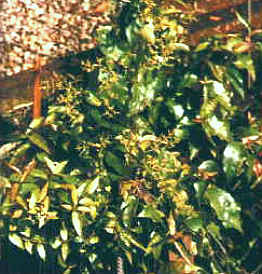
Plant Description
Caution & Interaction

Latin (botanical) name:
Pfaffia Paniculata
Common names: Suma, Brazilian Ginseng, Pfaffia, Para Todo, Corango-acu
Plant Description: Suma is a large, shrubby ground vine which has an intricate and deep root system. It is indigenous to the rainforests of the Amazon basin, as well as other tropical parts of Brazil, Ecuador, Panama, Paraguay, Peru, and Venezuela.
Medicinal Properties &Uses: Suma Root contains 19 different amino acids, a large number of electrolytes, and trace minerals including iron, magnesium, cobalt, silica, zinc, and vitamins A, B1, B2, E, K, and pantothenic acid. Suma is used as a tonic for the cardiovascular system, the central nervous system, the reproductive system, and the digestive system. It is an effective treatment for hormonal disorders and symptoms of menopause because of two hormones, sitosterol and stigmasterol. Additionally, it is helpful in the treatment of sexual dysfunction, infertility, and sterility. It has been used to restore nerve and glandular functions and to balance the endocrine system. As an immunostimulant, it is used to treat exhaustion caused by Epstein-Barr disease and Chronic Fatigue System. Hypoglycemia, mononucleosis, high blood pressure, and stress are also treated with Suma Root. Due to its anabolic agent, beta-ecdysterone, and three ecdysteroid glycosides contained in Suma Root, Russian Olympic athletes used the herb to increase muscle-building and endurance without the side affects associated with steroids. In addition, Suma Root has been used for arteriosclerosis, diabetes, rheumatism, and bronchitis.
Dosage: 30-60 drops in water or juice, 2-3 times daily or as needed. Shake well before using.
Cautions & Interactions: Keep out of reach of children.
Efficacy Studies & Other Clinical Data:
Disclaimer (U.S. Only): These statements have not been evaluated by the FDA. These products are not intended to diagnose, cure, treat, or prevent any disease.
Common names: Suma, Brazilian Ginseng, Pfaffia, Para Todo, Corango-acu
Plant Description: Suma is a large, shrubby ground vine which has an intricate and deep root system. It is indigenous to the rainforests of the Amazon basin, as well as other tropical parts of Brazil, Ecuador, Panama, Paraguay, Peru, and Venezuela.
Medicinal Properties &Uses: Suma Root contains 19 different amino acids, a large number of electrolytes, and trace minerals including iron, magnesium, cobalt, silica, zinc, and vitamins A, B1, B2, E, K, and pantothenic acid. Suma is used as a tonic for the cardiovascular system, the central nervous system, the reproductive system, and the digestive system. It is an effective treatment for hormonal disorders and symptoms of menopause because of two hormones, sitosterol and stigmasterol. Additionally, it is helpful in the treatment of sexual dysfunction, infertility, and sterility. It has been used to restore nerve and glandular functions and to balance the endocrine system. As an immunostimulant, it is used to treat exhaustion caused by Epstein-Barr disease and Chronic Fatigue System. Hypoglycemia, mononucleosis, high blood pressure, and stress are also treated with Suma Root. Due to its anabolic agent, beta-ecdysterone, and three ecdysteroid glycosides contained in Suma Root, Russian Olympic athletes used the herb to increase muscle-building and endurance without the side affects associated with steroids. In addition, Suma Root has been used for arteriosclerosis, diabetes, rheumatism, and bronchitis.
Dosage: 30-60 drops in water or juice, 2-3 times daily or as needed. Shake well before using.
Cautions & Interactions: Keep out of reach of children.
Efficacy Studies & Other Clinical Data:
-
Cancer Detection and Prevention Online - Pfaffia Paniculata
-
Healthway - Clinical Studies on Pfaffia Paniculata
Disclaimer (U.S. Only): These statements have not been evaluated by the FDA. These products are not intended to diagnose, cure, treat, or prevent any disease.